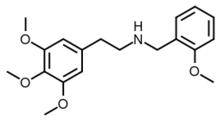NBOMe-mescaline
NBOMe-mescaline or mescaline-NBOMe is a synthetic substituted phenethylamine. It is a partial agonist of serotonin receptors with a 5-HT2A pKi originally reported as 7.3 (i.e. Ki of approximately 50nM),[1] though more modern techniques assayed it as 140nM at 5-HT2A and 640nM at 5-HT2C, making it one of the least potent compounds among the n-benzyl phenethylamines.[2]
 | |
| Clinical data | |
|---|---|
| Other names | mescaline-NBOMe; 345-NBOMe; N-(2-methoxybenzyl)-3,4,5-trimethoxyphenethylamine; 2-(3,4,5-trimethoxyphenyl)-N-[(2-methoxyphenyl)methyl]ethanamine; 3,4,5-Trimethoxy-N-(2-methoxybenzyl)phenethylamine |
| Routes of administration | Oral, intranasal, bucal, sublingual, intravenous |
| ATC code |
|
| Legal status | |
| Legal status |
|
| Pharmacokinetic data | |
| Elimination half-life | ? |
| Identifiers | |
IUPAC name
| |
| CAS Number | |
| PubChem CID | |
| ChemSpider | |
| Chemical and physical data | |
| Formula | C19H25NO4 |
| Molar mass | 331.4061 g/mol g·mol−1 |
| 3D model (JSmol) | |
SMILES
| |
InChI
| |
History
NBOMe-mescaline and NBOMe-escaline were first reported in 1999 resulting from research performed at Free University of Berlin concerning their activity as partial agonists at rat vascular 5-HT2A receptors.[1] NBOMe-mescaline was first reported in September 2008 to have been self administered by humans as a psychedelic drug at some unspecified point prior.[3] It first became available as a commodity in the research chemical market in May 2010 several months after a few 25x-NBOMes became available.
Properties and chemistry
Solubility of the hydrochloride salt: ~5 mg/ml in Phosphate Buffered Saline (PBS) @ pH 7.2; ~10 mg/ml in ethanol & DMF; ~20 mg/ml in DMSO.[4]
Synthesis
NBOMe-mescaline can be synthesized from mescaline and 2-methoxybenzaldehyde, via reductive alkylation. That can be done stepwise by first making the imine and then reducing the formed imine with sodium borohydride, or by direct reaction with sodium triacetoxyborohydride. An alternative production method which removes the need to obtain the illegal compound mescaline as an isolated precursor can be achieved via a one-pot reaction utilizing 3,4,5-trimethoxyphenylacetonitrile with Lithium Aluminium Hydride as a reducing agent.
Psychedelic dosage in humans
There have been very few reports of human use of NBOMe-mescaline. Psychedelic visual, auditory and mental effects start around 50 mg intranasally.[5]
Legal status
NBOMe-mescaline is not listed in the schedules set out by the United Nations' Single Convention on Narcotic Drugs from 1961 nor their Convention on Psychotropic Substances from 1971,[6] so the signatory countries to these international drug control treaties are not required by said treaties to control NBOMe-mescaline.
United States
NBOMe-mescaline is not listed in the list of scheduled controlled substances in the USA.[7] It is therefore not scheduled at the federal level in the United States, but it is possible that NBOMe-mescaline could legally be considered an analog of mescaline, and therefore sales or possession could potentially be prosecuted under the Federal Analogue Act.[8]
United Kingdom
This substance is a Class A drug in the United Kingdom as a result of the N-benzylphenethylamine catch-all clause in the Misuse of Drugs Act 1971.[9]
References
- Pertz HH, Rheineck A, Elz S (1999). "N-Benzylated derivatives of the hallucinogenic drugs mescaline and escaline as partial agonists at rat vascular 5-HT2A receptors". Naunyn-Schmiedeberg's Arch Pharmacol. 359 (Suppl 3): R29.
- Rickli A, Luethi D, Reinisch J, Buchy D, Hoener MC, Liechti ME (December 2015). "Receptor interaction profiles of novel N-2-methoxybenzyl (NBOMe) derivatives of 2,5-dimethoxy-substituted phenethylamines (2C drugs)" (PDF). Neuropharmacology. 99: 546–53. doi:10.1016/j.neuropharm.2015.08.034. PMID 26318099.
- 25B-NB (n-Benzyl-2C-B) @ BlueLight.org
- Cayman Chemical's Mescaline NBOMe HCl MSDS
- The Big & Dandy NBOMe-Mescaline Thread @ BlueLight.org
- UN International Drug Control Conventions
- §1308.11 Schedule I.
- Erowid Analog Law Vault : Federal Controlled Substance Analogue Act Summary
- "The Misuse of Drugs Act 1971 (Ketamine etc.) (Amendment) Order 2014". www.legislation.gov.uk.